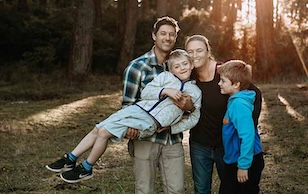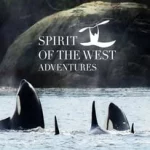September 16th, 2017
A molten sea stretches before me, a vast shimmering pool of shadow and light, unbroken by waves or the wind. I paddle rhythmically, dip, twist, pull and push, out, in, repeat. Close by eleven other kayakers are repeating the same motions; the only sounds are the gentle splash of our paddles and the swoosh of our PFDs on our spray skirts. One and a half hours down, one and a half to go. The crossing we had stared at in apprehension a few months ago on the charts spread out on the living room floor is now a surprisingly gentle reality.
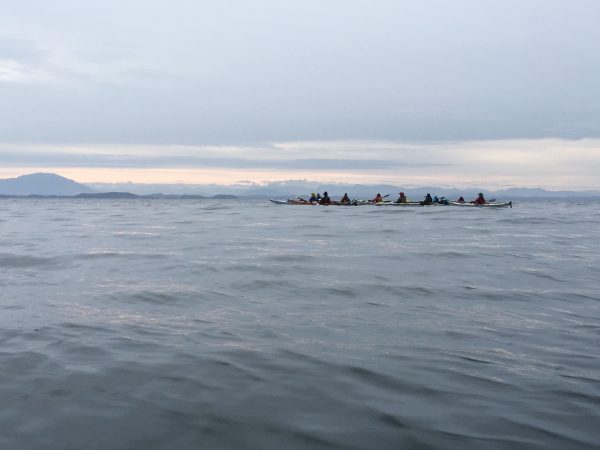
For seven of us, participating in this expedition in the Great Bear Rainforest was another checkmark on our bucket lists. All of us friends, living on Quadra Island, realized we shared a common dream, to kayak in the Great Bear Rainforest around Bella Bella, we knew we would be in unfamiliar and much more challenging conditions. When we learned that our local well-respected outfitter, Spirit of the West Adventures, was considering running its first ever expedition in this area the coming summer, we signed on immediately.
We met at the Quadra Island ferry on a beautiful Saturday afternoon in July, excitement running high, feeling more like kids on our way to summer camp than the seniors we really are, on our way to do some serious kayaking. Our Quadra contingent included Debbie and Norris, Kathryn and Mark, and Darcy, Margot, and myself, all on the far side of fifty, and five of us qualifying for B.C. Ferries’ reduced rates. Also on board were our two guides Graham and Sam, marketing coordinator and adventuress Melissa, and eight single and two double kayaks, gleaming brightly in the hot mid-day sun. We were to be joined by another B.C. explorer lady, Megan, and, at Bella Bella, by Fiona from Toronto.
Up before dawn, we are soon watching our kayaks being trundled on board the Northern Expedition. Dwarfed by the great open maw of the ferry, this was a striking visual reminder of how insignificant we would be in the busy channels around Bella Bella until we escaped into the outer waters.
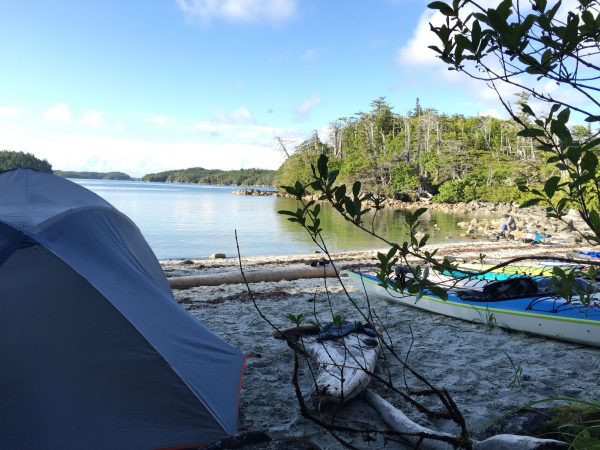
Finally, Bella Bella; all of our gear, including personal and the group’s, is now in an alarmingly large pile on the beach, the kayaks have been carried close to the waters’ edge. Oh, for Harry Potters’ wand, one wave and the right incantation to make all of that stuff just disappear into the nooks and crannies of the hatches. Wandless, we just have to do it ourselves. And this operation will be repeated twice a day for the next six paddling days.
“We quietly applaud our very sensible decision to go with a commercial outfitter!”
As is usual in expedition kayaking with a group, a double is included in the kayak mix; wisely, considering the length of this trip and conditions expected, S.O.W. has brought two doubles. While everyone is an experienced single kayaker and has indicated a preference for that, we expect to take turns paddling the double over the next week. Our personal gear goes in the back hatch of the same kayak each day; group gear goes in the forward hatch. Ten-litre dromedaries lay between our legs, these will be our only source of fresh water for the next eight days. Finally, almost twelve hours after getting up that morning, we are on the water looking for our first campsite.
A few hours of paddling south down Hunter Channel quickly reveals that campsites suitable for at least seven tents along the west shore of Denny Island are virtually non-existent. Finally, a steep pebbly beach adjacent to a lagoon outlet offers some promise.
At each camp a suitable area is established for the kitchen, which is always a work of folk art, contrived of driftwood, flotsam, and jetsam to provide cooking, serving, and eating areas. Despite the very long, demanding day, our guides soon have hot water for drinks, and ‘appies’ laid out on the driftwood to keep us happy while they prepare the first of the wonderful meals we enjoy throughout the trip. Tonight is grilled wild salmon, new potatoes, and salad, prepared on a two-burner camp stove; we quietly applaud our very sensible decision to go with a commercial outfitter. Dessert is carrot cake with cream cheese topping, yes, it was a very wise decision by us seniors!
A hummingbird flits around our brightly coloured PFDs laid out on the logs, looking for the nectar hidden in these strange new flowers. During the night, a heron complains loudly about the intruders in his quiet, private lagoon. Don’t worry, you will soon have it all to yourself again.
A lowering gray sky greets us the next morning. We pack our kayaks in a light rain that soon turns into a steady downpour, accompanied by southwest winds. Ironically, given the prevailing winds all summer, our routing is to be north to south, to take advantage of northwest winds.
We are heading southwest, out of the well-traveled Lama Passage, through Hunter Channel, towards an unnamed islet, informally called Islet 49, due its height designation on the Chart, in an archipelago off the south end of Campbell Island. This collection of islets is a kayakers’ delight, we paddle through a maze of green tunnels between the islands and islets, the rainforest thick to the waters’ edge.
The next beach on which we are camped spoke of centuries of native use, a midden meters deep, the eroded shells forming an almost sandy beach. In the forest, Graham, our guide, showed us a recently culturally modified cedar tree and explained the process of harvesting from the cedars to obtain the inner bark used in so many ways by the aboriginal people.
We leave the pretty beach somewhat regretfully, well knowing that on the West coast such easy landing and launching sites are a rarity, much appreciated when found. As we travel we begin to pick up the subtle swells of the open ocean, several kilometers further west. In a small lagoon, where we take a short break, our kayaks are bobbing in the gentle wave action, as if eager to finally meet the real ocean out there.
“The ocean begins to breathe beneath us, long, slow, steady breaths; we are suspended on the lungs of the world.”
We are now in the Tribal Group, a collection of small islands and islets that seem to sprout directly out of the water. The trees, crowded onto the low-lying rocky islets, are sheared and pruned by the winter storms; each islet is a tight profusion of green; every west coast plant flourishes here in copious abundance.
Along with the plant life onshore, the life in the water is also evidence of this wilder marine environment. The familiar Bull Kelp is joined by the Giant Kelp and the exotic Feather Boa Kelp; we learn to accelerate through to avoid getting caught up in the metres long fronds. Curious sea otters are now making the occasional appearance, disappearing into the kelp with a quick swish of a thin tail. Two sea lions, perched on a kelp-ringed rock, watch cautiously as we glide by.
We make the final crossing to the McMullin Group, a distant blur of green on the horizon, nothing living visible beyond. The ocean is green, heaving steadily, the boom of the surf crashing onto the outer edges of the archipelago resonates close by, the safety of the mainland is far to the east, ringed with clouds and barely visible. We are further out than we have ever been before, we feel as if we have kayaked onto the edge of the world.
Another pleasant discovery is the many tidal pools, soon named Cleopatra’s Baths as we enjoy the opportunity to bathe and shampoo, albeit in saltwater.
Sam, our second guide, is in charge of the loo, a most important duty, especially that of choosing just the right site, away from camp, but not too far, and in a setting conducive to appropriate contemplations. At our McMullin camp, Sam outdoes himself in site selection, choosing a unique location high on a rocky outcrop, looking northeast over the waters we have just paddled and roofed by a massive driftwood log.
“Truly a loo-with-a-view not to be found even in the grandest of mansions; priceless.”
On the next morning, we leave the protection of the McMullin Group and the wave action becomes much stronger. Heading south, crossing the Golby Passage towards Goose Island, we are now fully exposed to the open ocean. Our kayaks ride the swells like a thrill ride at a fairground; you’re up, I’m down, now I see you, now I don’t.
The forty-five-minute crossing is made more challenging by the strong current threatening to sweep us out into the open ocean. At about the half-way point we have officially entered the Hakai Luxvbalis Conservancy Area. Located within the traditional territory of the Heiltsuk nation, this is the largest provincial marine protected area on the British Columbia coast and is accessible only by sea or air. We feel privileged to be able to explore this truly unique aquatic paradise.
Finally, we land at a wide, sandy crescent beach, the biggest stretch of sand we have seen so far. While we stretch our legs and explore this ancient historical site, our guides are busily preparing another hearty lunch. Ahh, the pleasures of a guided trip.
This beach was once the site of a native recovery centre. The big house is now returning to the forest, but still reveals the original design and structure, modeled on a traditional long house, with wide platforms around a large firepit. This remote and peaceful location would have been an ideal place to reconnect with nature and oneself.
At the far end of the long beach is the tent of a lone kayaker, only the second person we have encountered since leaving Bella Bella.
Our pleasant sojourn is soon just a fond memory. When we round the north-east corner of Goose Island, heading south down Queens Sound, we are greeted with strong southerlies and an opposing current, greatly slowing our progress.
Finally, we round Gosling Island, mercifully out of the wind and into a calm channel between islets.
“Once again, we are in another world of luxuriant rainforest spilling to the waters’ edge.”
Snipe Islet is a double-sided arc, a narrow two-meter high spine of the forest with sandy beaches on both sides providing ample space for all of us. I opt for the east side of the spit, pitching my tent beside an old growth driftwood stump that we estimate is 600 years old.
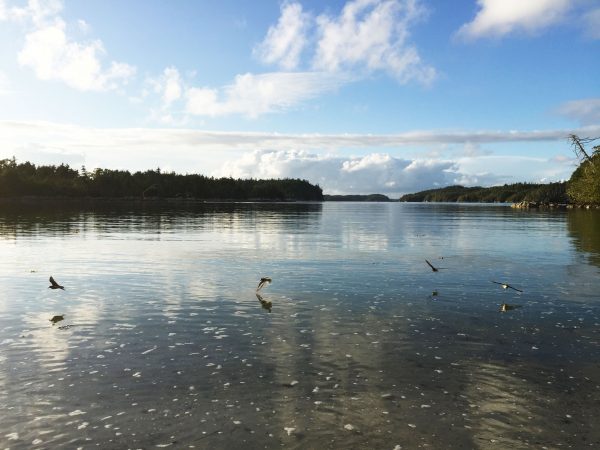
We break camp just before dawn and are on the water very soon after that. The unsettled weather is forecast to get worse, with strong to gale force winds to arrive by noon the next day, and to persist for at least the next twenty-four hours. To avoid being stranded on these remote islands for days, our only option is to leave ahead of the winds.
The great crossing across Queen’s Sound, the defining challenge of the trip, is now upon us. Being confident enough in our own abilities, and physically capable, to undertake a 9 km, 3 hour open water crossing, exposed directly to the open ocean, in probably difficult conditions, was the final go/no-go decision my friends and I had made that day when the charts were laid out on Kathryn’s living room floor.
Our guides set a steady pace and we concentrate on staying together, pointing our kayaks towards Purple Bluff, now just a bump on the eastern horizon.
“The vastness of the waters around us is breathtaking; we are tiny specks in a very large sea.”
We pass by Purple Bluff and into the channels of the Simonds Group, back again in the more familiar and reassuring landscape of rocky islets and rainforest. But the threatened winds have arrived, the short crossing to the McNaughtons Group is a wild and wind-tossed affair.
The narrow east-west channel cleaving the McNaughtons has transported us yet again to another world. In this calm channel, the low tide exposes a riot of marine life clinging to the vertical walls. We glide close, fascinated by the abundance and variety; anemones, limpets, snails, nudibranchs. We could stay here for days just exploring and identifying the life in this natural aquarium. Graham plucks out a fat, red, spiky California Sea cucumber for us to admire.
But we still have several kilometers to go, so we reluctantly leave this watery Eden and turn south, towards Cultus Sound and our campsite on the north-west tip of Hunter Island.
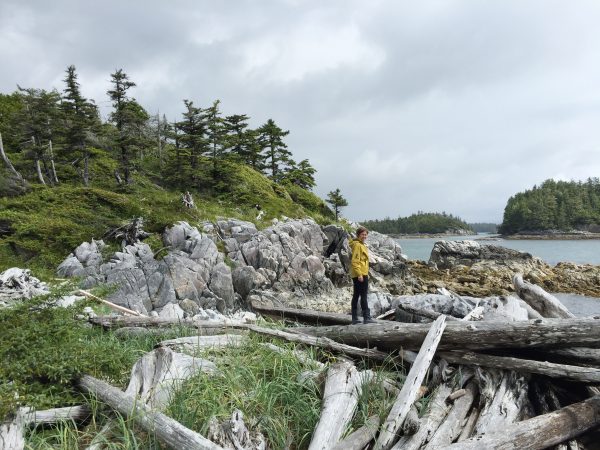
This campsite again offers the luxury of space.Camping on a sandy beach sounds very appealing, the reality is wet sand in everything, including, despite my best efforts, my sleeping bag. I will not need any beauty treatments for a year, this is my third night of free dermabrasion.
In the following morning, once more we set off, having heard yet again of the storm and gale warnings on the marine radio. Our route is to take us through the rocky outcroppings behind Superstition Point, hopefully avoiding the worst of the weather in the open waters of Queens Sound.
We soon see just what is in store for us, a giant’s washtub of disorganized water, waves, wind and rebound waves throwing the ocean in every direction. I have no time to spend looking out for the rest of the group, all of my concentration is on keeping my own kayak off the rocks all around. Graham leads us through a narrow channel, just wide enough for one kayak. We have to take turns, waiting for the oncoming waves to subside just enough so that we are not smashed into the rocks on either side.
After the hardest paddling I, or any of our Quadra group, have ever done, we slip into the sanctuary of Spitfire Channel. Though out of the rough conditions, the wind is still against us, and heavy rains start just as we finally arrive at camp. Wise at last, I opt for a site in the woods just above the beach; mud is a better option, I decide than wet sand.
The rain stops in the morning and Graham and Sam have the coffee on; we are soon gathered under the kitchen tarp, wondering just what to do with the luxury of a whole day in camp. Of course, what else but go for a paddle to explore the islands and islets around Triquet.
The sky begins to clear, looming gray clouds give way to white puffy cumulus, the sun peeks through. Immediately the beach looks like a paddlers’ garage sale, tents, flies, sleeping bags, foamies, PFDs, spray skirts, pants, shirts, shoes, and socks, strewn about on the black rocks and driftwood. It is even warm enough to lay on the beach to read, to write, to draw, or chat, or sleep.
We pack up quickly the next morning. All of the gear will be loaded directly onto the water taxi. When the first water taxi arrives we form a human chain, passing our gear onto the boat deck. The four men, aided by the captain, carefully manoeuver the first batch of kayaks onto the roof of the taxi.
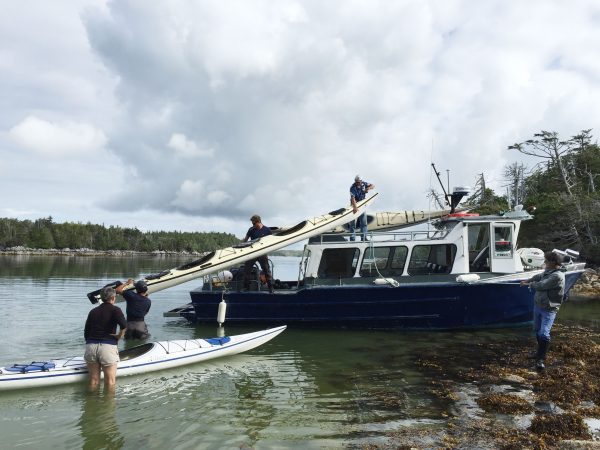
Back at the B.C. Ferries dock in Bella Bella. Our gear is loaded onto the ferry cart, the kayaks lined up like colourful, benign torpedoes ready to be loaded onto the ferry’s trailer.
We have several hours to celebrate the end of the journey of a lifetime.
“For our group of Quadra seniors, we have achieved above and beyond our expectations.”
We paddled over 120 kilometers in eight days in the wind and the rain, camping in mud and wet sand, braving two-met swells and 20-knot winds, in the most demanding and challenging conditions we have ever faced. We joke that, if anything had happened on the trip, the headlines would have read “Elderly kayakers …..”. Before we disembark, we have already decided on our next adventure.

